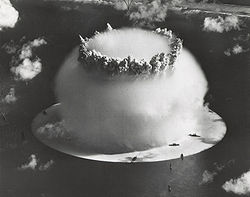 LSM-60 with modifications for the Baker Test, Bikini Atoll | |
| History | |
|---|---|
| Name | USS LSM-60 |
| Builder | Brown Shipbuilding, Houston, Texas |
| Laid down | 7 July 1944 |
| Launched | 29 July 1944 |
| Commissioned | 25 August 1944 |
| Honors and awards | 1 battle star (World War II) |
| Fate | Destroyed during "Operation Crossroads" Test Baker, 25 July 1946 |
| General characteristics | |
| Class & type | LSM-1 class Landing Ship Medium |
| Displacement |
|
| Length | 203 ft 6 in (62.03 m) o/a |
| Beam | 34 ft 6 in (10.52 m) |
| Draft |
|
| Propulsion | 2 × Fairbanks-Morse (model 38D81/8X10, reversible with hydraulic clutch) diesels. Direct drive with 1,440 bhp (1,074 kW) each @ 720 rpm, twin screws |
| Speed | 13.2 knots (15.2 mph; 24.4 km/h) |
| Range | 4,900 nmi (9,100 km) at 12 kn (22 km/h) |
| Capacity | 5 medium or 3 heavy tanks, or 6 LVT's, or 9 DUKW's |
| Troops | 2 officers, 46 enlisted |
| Complement | 5 officers, 54 enlisted |
| Armament | 6 × 20 mm AA gun mounts |
| Armour | 10-lb. STS splinter shield to gun mounts, pilot house and conning station |
USS LSM-60 was a World War II era landing ship, medium (LSM) amphibious assault ship of the United States Navy. It was notable for being used as the float to suspend a fission bomb underwater during the Operation Crossroads BAKER test, becoming the first naval vessel to deploy a nuclear weapon. [1]
